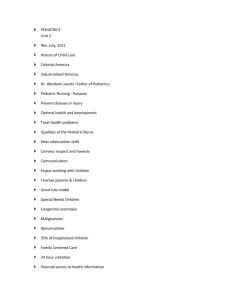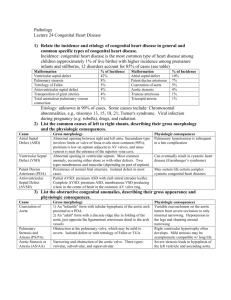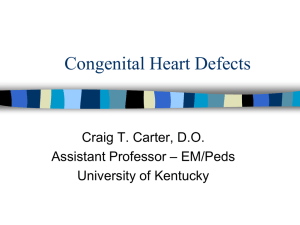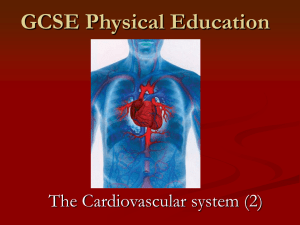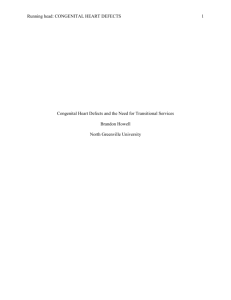Chapter 26 The Child with a Cardiovascular Disorder Objectives
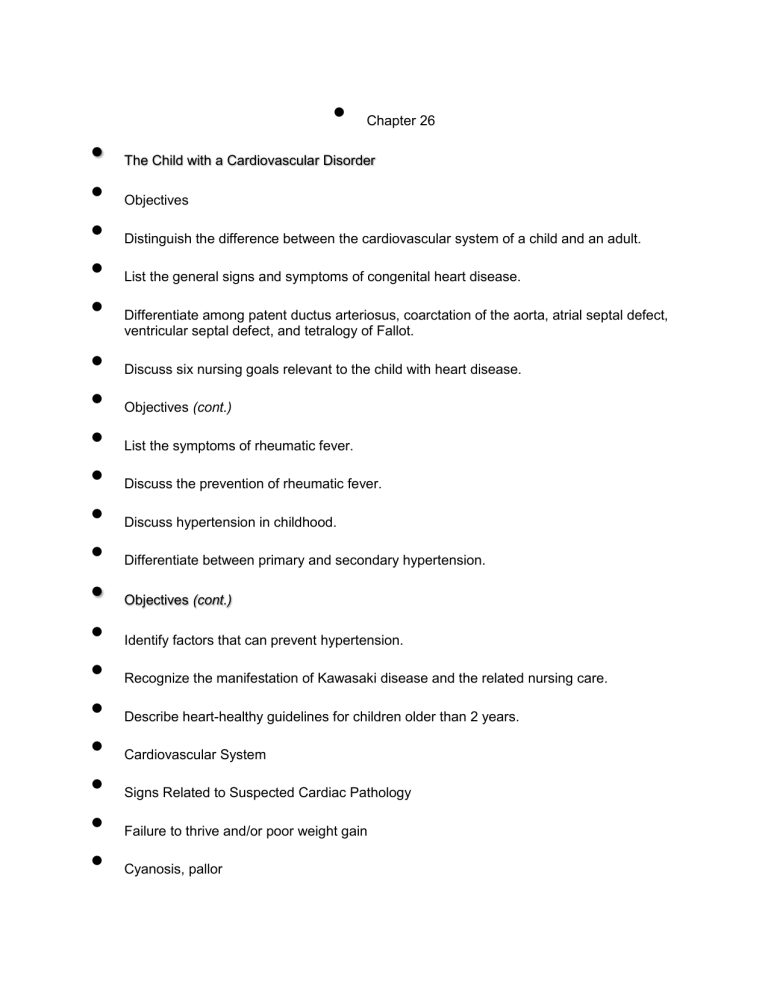
•
•
•
•
The Child with a Cardiovascular Disorder
Chapter 26
•
Objectives
•
Distinguish the difference between the cardiovascular system of a child and an adult.
List the general signs and symptoms of congenital heart disease.
Differentiate among patent ductus arteriosus, coarctation of the aorta, atrial septal defect, ventricular septal defect, and tetralogy of Fallot.
•
•
•
•
•
•
•
•
•
•
•
•
Discuss six nursing goals relevant to the child with heart disease.
Objectives (cont.)
•
List the symptoms of rheumatic fever.
•
Discuss the prevention of rheumatic fever.
Discuss hypertension in childhood.
Differentiate between primary and secondary hypertension.
Objectives (cont.)
Identify factors that can prevent hypertension.
Recognize the manifestation of Kawasaki disease and the related nursing care.
Describe heart-healthy guidelines for children older than 2 years.
Cardiovascular System
Signs Related to Suspected Cardiac Pathology
Failure to thrive and/or poor weight gain
Cyanosis, pallor
•
•
•
•
•
•
•
•
Visually observed pulsations in the neck veins
Tachypnea, dyspnea
Irregular pulse rate
Clubbing of fingers
Fatigue during feeding or activity
Excessive perspiration, especially over forehead
Congenital Heart Disease
Occurs in approximately 8 out of 1,000 births
•
50% of these infants show signs/symptoms within the first year of life
•
Can be caused by genetic, maternal, or environmental factors
–
–
Not a problem for the fetus because of the fetal-maternal circulation
At birth, the infant ’ s circulatory system must take over and provide the child ’ s oxygen needs
•
•
Congenital Heart Disease (cont.)
Of the congenital anomalies, heart defects are the principal cause of death during the first year of life
•
Diagnostic studies vary from noninvasive, such as an electrocardiogram, to invasive, such as angiogram
•
•
•
Once diagnosis is confirmed, most cardiac defects require surgical intervention
•
Congenital Heart Disease (cont.)
Classification
Two categories
–
–
Cyanotic
Acyanotic
•
Blood always flows from area of high pressure to an area of low pressure and it also takes the path of least resistance
•
•
Congenital Heart Disease (cont.)
Physiologically, defects can be organized into lesions that
–
–
–
Increase pulmonary blood flow
Obstruct blood flow
Decrease pulmonary blood flow
•
A shunt refers to the flow of blood through an abnormal opening between two vessels of the heart
•
•
•
The Normal Heart and Various Congenital Heart Defects
Congenital Heart Disease (cont.)
Defects that increase pulmonary blood flow
–
Blood returns to the right ventricle and recirculates through the lungs before exiting the left ventricle through the aorta
•
•
•
•
•
Some defects that increase pulmonary flow are
–
–
Atrial septal defect
Ventricular septal defect and patent ductus arteriosus
The oxygenated blood recirculates to the lungs, and cyanosis is rare
Nursing Tip
In congenital heart disease, cyanosis is not always a clinical sign
Restrictive Defects
•
Restriction usually from some form of stenosis of the vessel
–
Coarctation of the aorta
•
Narrowing or constriction of the aortic arch or of the descending aorta
•
Hemodynamically, increased pressure proximal to the defect and decreased pressure distally
•
•
•
•
•
•
Coarctation of the Aorta
Characteristic symptoms
Marked difference in the blood pressure and pulses of the upper and lower extremities
May not develop symptoms until late childhood
Treatment is dependent upon type and severity of the defect
Best time for surgical intervention is between 2 and 4 years of age
•
Coarctation of the Aorta (cont.)
•
If left untreated
–
Hypertension
–
Congestive heart failure
–
Infective endocarditis may occur
•
After surgery, the nurse should observe for
–
Hypertension
–
Abdominal pain associated with nausea and vomiting
–
Leukocytosis
–
GI bleeding or obstruction
•
Treatment includes
–
Antihypertensive drugs
–
Steroids
–
NG tube for decompression of the stomach
•
•
Defects that Decrease Pulmonary Blood Flow
Occurs when a congenital heart anomaly allows blood that has not passed through the lungs (unoxygenated blood) to enter the aorta and general circulation
•
Cyanosis caused by the presence of unoxygenated blood in the circulation is a characteristic feature of this type of congenital heart anomaly
•
•
Tetralogy of Fallot
Four defects
•
Stenosis or narrowing of the pulmonary artery
–
Decreases blood flow to the lungs
•
Hypertrophy of the right ventricle
–
Enlarges because it must work harder to pump blood through the narrow pulmonary artery
•
•
•
Dextroposition of the aorta
•
–
The aorta is displaced to the right and blood from both ventricles enters it
Ventral septal defect (VSD)
•
Tetralogy of Fallot (cont.)
Cyanosis increases with age
Clubbing of fingers and toes
–
Due to chronic hypoxia
•
Child rests in a “ squatting ” position to breathe more easily by altering systemic venous return
•
Prevalent symptoms include
–
–
Feeding problems
Failure to thrive
•
•
•
•
•
•
–
–
–
Frequent respiratory infections
Severe dyspnea on exertion
Polycythemia develops to compensate for the lack of oxygen
•
Paroxysmal Hypercyanotic Episodes
•
Known as Tet spells
•
•
Occur during the first 2 years of life
Spontaneous cyanosis, respiratory distress, weakness, and syncope occur
•
They can last up to a few hours and are followed by lethargy and sleep
•
Place child in knee-chest position when Tet spell occurs
Tet Position
Diagnosis
Diagnosis confirmed by chest X-ray that shows a typical boot-shaped heart
Additional tests include
–
–
–
EKG
3-D echocardiography
Cardiac catheterization
Complications and Treatments
Complications
–
–
Cerebral thrombosis caused by polycythemia, especially if dehydration occurs
Iron-deficiency anemia due to decreased appetite and increased energy required to suck or eat
–
Bacterial endocarditis can occur
•
Treatment
–
Designed to increase pulmonary blood flow to relieve hypoxia
•
Surgery
–
In some cases, IV prostaglandin E therapy can open a constricted ductus arteriosus and allow for oxygenation of the body until surgery is performed
•
•
Defects that Cause Mixed Pathology
Hypoplastic left heart syndrome
–
–
Underdevelopment of the left side of the heart
Usually results in an absent or nonfunctional left ventricle and hypoplasia of the ascending aorta
–
Can be diagnosed before birth and infant is placed on a heart transplant list early
•
•
Defects that Cause Mixed Pathology (cont.)
Hypoplastic left heart syndrome (cont.)
–
Initial survival depends on a patent foramen ovale and ductus arteriosus to provide a pathway for oxygenated blood to the general body system
•
–
Symptoms include
•
•
•
A grayish-blue color of the skin and mucous membranes
•
Signs of CHF
Dyspnea
Weak pulses
•
Cardiac murmur
•
General Treatment and Nursing Care
•
Assorted medical and surgical treatments are currently available
After the procedure, the nursing care involves
–
–
–
–
Monitoring vital signs
Observing for thrombosis formation
Neurovascular checks of the limb
Emotional support to child and family
•
•
General Treatment and Nursing Care (cont.)
Instruct parents that children with congenital heart disease should avoid competitive sports because the pressure for a team win can interfere with the child ’ s need to stop activity if specific symptoms arise
•
Nutritional guidance aimed at preventing anemia and promoting optimal growth and development
•
•
•
Vacations to high altitudes or very cold environments may cause adverse responses in a child who is already hypoxic or has cardiac problems
•
•
Acquired Heart Disease
Occurs after birth
•
May be a complication of a congenital heart disease or a response to respiratory infection, sepsis, hypertension, or severe anemia
•
Heart failure is a decrease in cardiac output necessary to meet the metabolic needs of the body
Congestive Heart Failure (CHF)
Manifestations depend on the side of the heart affected
–
Right side of the heart moves unoxygenated blood to the pulmonary circulation
•
A failure results in the backup of blood in the systemic venous system
–
Left side of heart moves oxygenated blood from the pulmonary circulation to the systemic circulation
•
Failure results in backup into the lungs
•
Congestive Heart Failure (CHF) (cont.)
•
•
–
–
–
–
–
–
•
•
•
When body tries to compensate
–
–
–
–
•
Safety Alert
•
Early signs of CHF in infants that should be reported
–
–
–
–
–
Peripheral vasoconstriction occurs
Results in cold and/or blue hands and feet
Tachycardia
Tachypnea
Tachycardia at rest
Fatigue during feedings
Sweating around scalp and forehead
Dyspnea
Sudden weight gain
CHF Goals of Treatment
Goals
Reduce the work of the heart
Improve respiration
Maintain proper nutrition
Prevent infection
Reduce the anxiety of the patient
Support and instruct the parents
CHF and Nursing Care
Organize care so that infant is not unnecessarily disturbed
•
•
•
•
•
•
•
Feed early if crying and late if asleep
Feedings are small and frequent
Oxygen is administered to relieve dyspnea
Medications are given as prescribed, after dosages are checked for safety
Accurate recording of intake and output
Rheumatic Fever (RF)
Systemic disease involving the joints, heart, central nervous system, skin, and subcutaneous tissues
–
Belongs to a group of disorders known as collagen diseases
•
Common feature is destruction of connective tissue
–
Scars mitral valve in the heart
•
Peak incidence is 5 to 15 years of age
–
More prevalent in winter and spring
•
Autoimmune disease occurring as a complication of an untreated group A beta hemolytic streptococcus infection of the throat
•
Manifestations of RF
•
Modified Jones Criteria
•
Minor criteria
–
Fever
–
Arthralgia
–
Previous history of rheumatic heart disease
–
Elevated erythrocyte sedimentation rate
–
–
Leukocytosis
Altered PR interval on electrocardiogram
–
Positive C-reactive protein
•
A positive diagnosis of RF cannot be made without the presence of two major criteria or one major and two minor criteria, plus a history of streptococcal infection
•
•
•
•
•
•
•
•
•
Modified Jones Criteria (cont.)
Major Criteria
–
–
–
–
–
Carditis
Polyarthritis
Erythema marginatum
Chorea
Subcutaneous nodules
Treatment of RF
Antimicrobial therapy initially, then followed by chemoprophylaxis monthly for a minimum of 5 years
Rest
Relief of pain and fever
–
–
–
Antiinflammatory agents
Steroids
Aspirin
Management of cardiac failure, should it occur
Nursing Care of RF
Care should be organized to ensure as few interruptions as possible to prevent tiring the patient
•
Special attention should be given to skin and back care; good oral hygiene; and small, frequent feedings
•
•
•
•
•
•
•
•
•
•
•
•
If dental therapy is needed, prophylactic antimicrobial treatment is required before the procedure
•
Prevention of RF
•
Prevention of infection and prompt treatment of group A beta-hemolytic streptococcal infections
Nurse stresses importance of completing all antimicrobial therapy as prescribed
Systemic Hypertension
More prevalent during childhood and adolescence
Significant hypertension (HTN) is considered when measurements are persistently at or above the 95 th percentile for patient ’ s age and sex
Primary, or essential, HTN implies that no known underlying disease is present
When the cause of hypertension can be explained by a disease process, it is known as secondary
–
Renal, congenital, vascular, and endocrine
Systemic Hypertension (cont.)
Heredity, obesity, stress, and poor diet and exercise patterns are some of the contributing factors to the development of HTN
HTN more prevalent in children whose parents have high blood pressure
Systemic Hypertension (cont.)
Treatment and nursing care involve
–
–
–
–
Nutritional counseling
Weight reduction
Age-appropriate program of aerobic exercise
Adolescents should be counseled concerning the adverse effects of drugs, alcohol, and tobacco on blood pressure
•
Focus of treatment of secondary HTN is the underlying disease causing the elevated blood pressure
•
•
•
•
•
Nonpharmacological Approach to HTN
•
Aerobic exercise
Reduce sedentary activities
Weight reduction
•
•
•
Dietary management
•
Adequate intake of potassium and calcium
Avoid smoking and those who smoke
Hyperlipidemia
Refers to excess lipids (fat and fatlike substances in the blood)
Lipoproteins contain lipids and proteins and include
–
Low-density lipoproteins (LDL) contain low amounts of triglycerides, high levels of cholesterol, and some protein
•
Carries cholesterol to the cells, which aids in cellular metabolism and steroid production
–
High-density lipoproteins (HDL) contain low amounts of triglycerides, little cholesterol, and high levels of protein
•
Carries cholesterol to the liver for excretion
•
•
Hyperlipidemia (cont.)
Children with two consecutive blood cholesterol levels exceeding 170 mg/dL should be followed closely and offered nutritional guidance
–
Parental history of cholesterol levels exceeding 240 mg/dL or a family history of early cardiac death (under age 55 years) should have their cholesterol levels tested
•
Dietary intake of no more than 300 mg of cholesterol per day and no more than 30% total dietary calories from fat are recommended
–
Children younger than 2 years of age should not have a fat-restricted diet, because calories and fat are necessary for CNS growth and development
•
•
•
•
•
Kawasaki Disease (KD)
Also known as mucocutaneous lymph node syndrome
Leading cause of acquired cardiovascular disease in the U.S.
Usually affects children younger than 5 years of age
May be a reaction to toxins produced by a previous infection with an organism such as
Staphylococci
•
•
•
Not spread from person to person
•
Kawasaki Disease (KD) (cont.)
•
Diagnosis is made by clinical signs and symptoms, no specific lab studies
•
KD causes inflammation of the vessels in the cardiovascular system
–
Weakens the walls of the vessels
•
Often results in an aneurysm (an abnormal dilation of the wall of a blood vessel)
–
Aneurysms can cause thrombi (blood clots) to form, which can be life-threatening
Kawasaki Disease (KD) (cont.)
Manifestations
–
Onset is abrupt with a sustained fever
•
As high as 104 º F (40 º C)
•
Does not respond to antipyretics or antimicrobials
•
Fever lasts for more than 5 days
–
–
Conjunctivitis without discharge
Fissured lips
•
•
•
•
•
–
A “ strawberry tongue ”
–
Inflamed mouth and pharyngeal membranes
–
Enlarged nontender lymph nodes
•
•
Kawasaki Disease (KD) (cont.)
Erythematous skin rash develops
•
Swollen hands and desquamation (peeling) of the palms and soles
•
Child is very irritable
May develop signs of cardiac problems
Kawasaki Disease (KD) (cont.)
Treatment
–
IV gamma globulin, if given early, can prevent the development of coronary artery pathology
–
–
Salicylate therapy for antithrombus properties
Warfarin therapy may be prescribed if aneurysms are detected
Kawasaki Disease (KD) (cont.)
Nursing care
–
–
Symptomatic and supportive
Parent teaching should be reinforced concerning need to postpone active routine immunizations for several months after the administration of immune globulin, which is an immunosuppressant
–
Long-term, low-dose aspirin therapy may be prescribed
•
Compliance may be a problem for any long-term regimen in which medications must be taken when the child feels “ well.
”
•
Question for Review
•
•
•
•
How does the squatting (Tet) position relieve dyspnea?
Review
Objectives
Key Terms
•
•
Key Points
Online Resources
•
Review Questions

